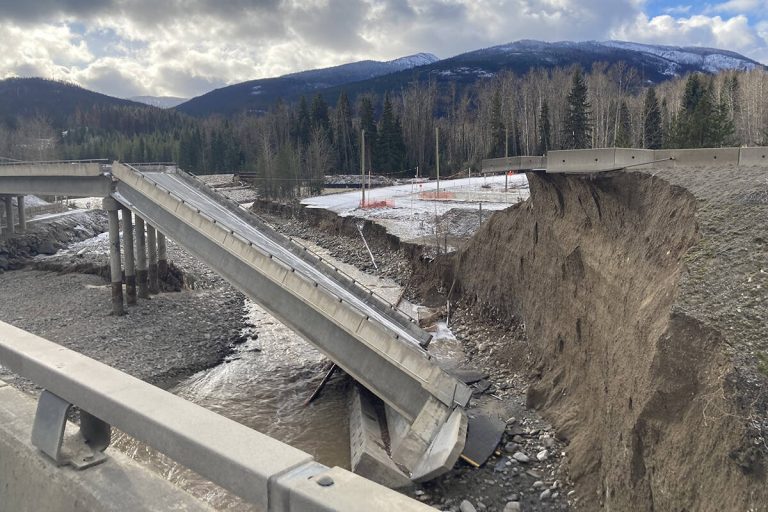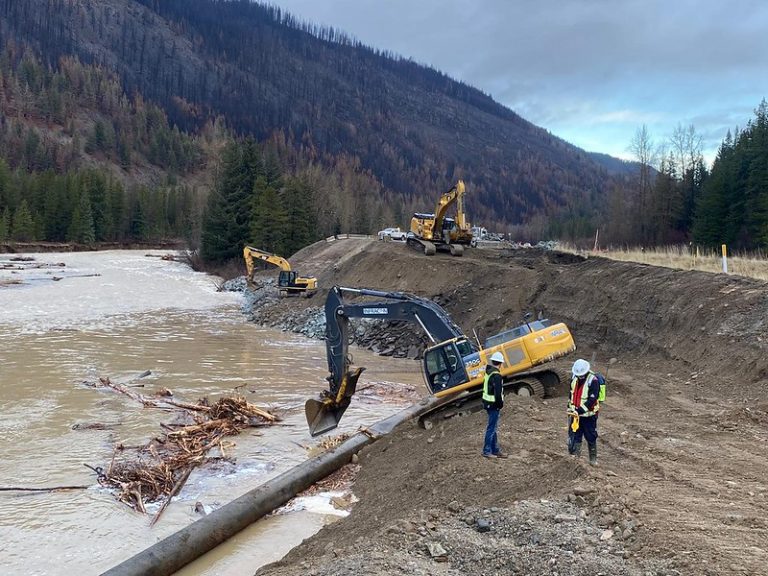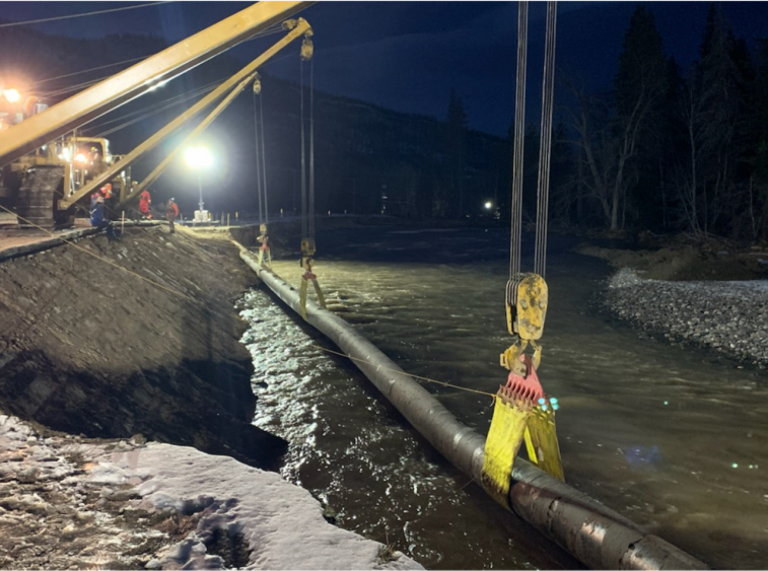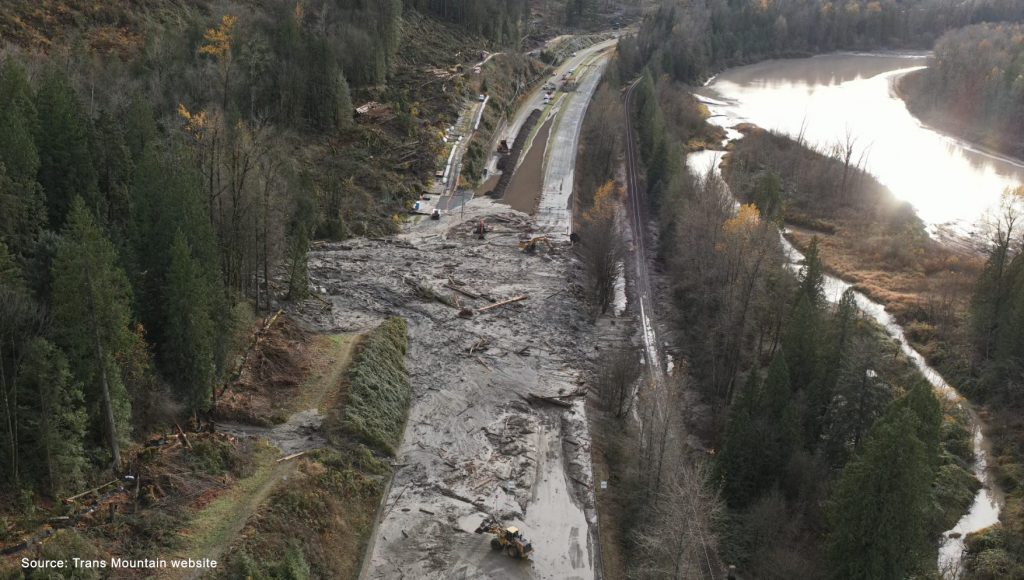What if we future-proofed B.C. instead of building more pipelines?
Trans Mountain is under water. Its federal dollars and skilled workforce should be redeployed to build back better after the floods.
“It’s going to take a bundle of money.” With that understatement, Premier Horgan announced a new joint federal-provincial committee in the immediate aftermath of November’s catastrophic B.C. floods. The committee is supposed to help the province ‘build back better,’ helping to protect infrastructure and communities from future extreme weather events — and reach our climate goals.
As the full toll of the deadly B.C. floods has begun to emerge, it has become clear that the province is facing eye-watering repair bills. These come on top of a stack of other costs this year associated with wildfires and the pandemic, and have leading credit agencies like Moody’s worried about the provincial economy.
Here’s an idea: why not take the billions of federal dollars and thousands of workers currently building a vulnerable, climate-killing oil pipeline and put them to work rebuilding a climate- resilient B.C. instead?
The resources we need are right in front of us
The Coquihalla highway alone broke in at least 20 places, where torrents of mud, rock and water snapped it like pick-up sticks. Repairing it is a costly, herculean task — all the more so if the work is done right, with future climate disasters in mind. Building back better means that the hundreds of damaged and destroyed roads, bridges, water and gas lines and other infrastructure needs to be rebuilt to withstand the next “once in a hundred year” extreme weather event when it comes along much, much sooner than that.

Source: B.C. Ministry of Transportation
There are 300 people and 200 pieces of heavy machinery currently working around the clock on the Coquihalla. Temporary repairs will soon allow the highway to re-open, but to commercial traffic only. Everyday people hoping to use B.C.’s main artery to travel across the province and the country will have to wait, with full repairs expected to take much of 2022.
Meanwhile, 570 workers got the existing Trans Mountain pipeline back up and running in 21 days. According to Trans Mountain, the expansion project currently has a workforce of 5,600 at its disposal. This project has the exact right people, skills, equipment and materials needed to rebuild this province. And every drill, bulldozer, metre of steel and hour of wages is being paid for by Canadian taxpayers.
B.C. is facing an acute workforce shortage. With two major pipeline projects underway, economists point out that governments will be forced to pay inflated costs for flood reconstruction by pulling capacity from elsewhere. Or, the federal government could choose to re-allocate Trans Mountain’s resources.
Building a climate resilient B.C. doesn’t stop with flood relief. Once infrastructure is repaired, we need skilled workers to retrofit every single home and building with heat pumps to lower fossil fuel use and keep vulnerable people cool during future heat waves. And build solar farms and electric buses. And help fight forest fires. The list goes on and on.
A wartime-scale mobilization that confronts the climate crisis, and protects people from the worst of symptoms of climate breakdown that are already locked in, could transform our economy and generate long-term security and prosperity. But right now, the jobs, skills and government infrastructure dollars required are being poured into new fossil fuel projects.
Trans Mountain under water
The potent symbolism of an oil pipeline being struck down by a climate disaster is hard to ignore. Grim photos published by Trans Mountain shows at least 14 locations where the existing pipeline was exposed, damaged, or washed over by the powerful floods. These reveal how close we came to a major oil spill, and how vulnerable long, linear infrastructure like pipelines are in the face of extreme weather that will only grow more frequent.

Source: BC Government / Flickr creative commons

Source: Trans Mountain
The floods — like this summer’s fires — also disrupted construction on the expansion project, and even changed the entire course of major rivers that it will need to cross. TMX is now considering re-routing the new line, which could in turn force governments to re-open environmental assessment processes. All of this adds significant delays and costs to a project that has already been plagued with a string of shut-downs and disruptions, and whose price tag has already ballooned out of control.
It’s been nearly two years since taxpayers were last provided with a cost update, and during that time, the circumstances in which TMX was approved have changed beyond recognition.
The pandemic plunged oil markets into chaos; the UN declared a ‘climate code red’ as extreme weather ramped up climate concern in B.C. and around the world; international energy forecasters called on governments to stop expanding oil and gas; hundreds of economists denounced TMX’s economic viability; and Canadian agencies made it clear that new federal climate policies mean that TMX is both unnecessary and unlikely to be profitable. Oh, and Canada’s new environment minister is a former Greenpeace staffer who once dangled from Toronto’s CN tower in a protest against oil expansion.
A political ‘Act of God’ clause
Everything has changed, and whatever political or economic calculations Justin Trudeau’s Liberals relied on to approve Trans Mountain simply don’t hold up anymore. Instead of driving over a cliff to avoid admitting they made the wrong call, pivoting TMX’s resources to build back better after the B.C. floods offers an exit ramp. Taking it would protect jobs, reduce emissions and build infrastructure and energy systems that will stand up to the future disasters coming our way.
While Horgan’s NDP is under fire for championing a different dead-end pipeline, it’s nominally still opposed to Trans Mountain. Rather than leaving broken infrastructure and flooded out families hanging, and taking a huge hit in next year’s provincial budget, Horgan could choose to lean on the federal government to re-allocate Trans Mountain’s workforce and equipment. Imagine how far the pipeline’s budget — now estimated to be $20 billion or more — could go.
Putting more taxpayer money into pipelines only ensures that future disasters will hit harder — and cost us more to clean up.

